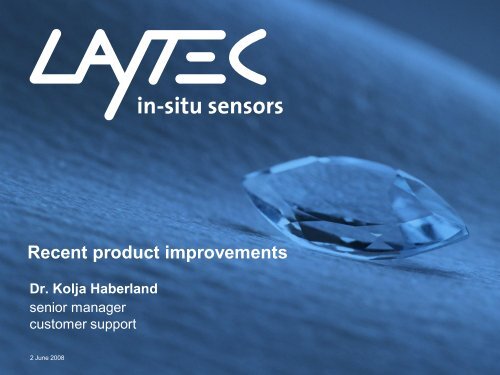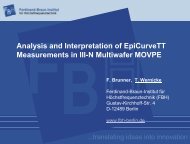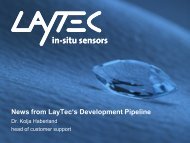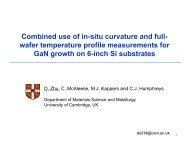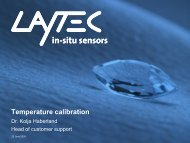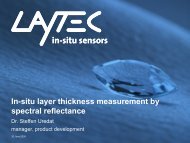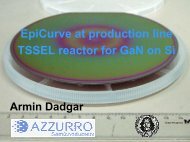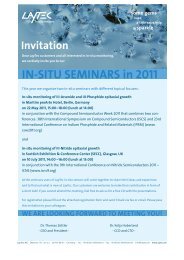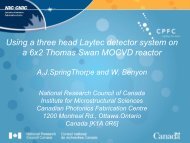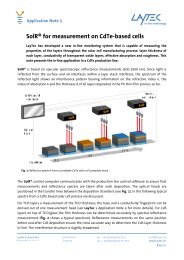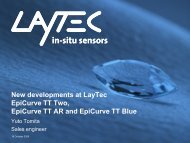EpiTT / EpiCurve®TT LED-based for CCS reactor - Laytec
EpiTT / EpiCurve®TT LED-based for CCS reactor - Laytec
EpiTT / EpiCurve®TT LED-based for CCS reactor - Laytec
Create successful ePaper yourself
Turn your PDF publications into a flip-book with our unique Google optimized e-Paper software.
Recent product improvements<br />
Dr. Kolja Haberland<br />
senior manager<br />
customer support<br />
2 June 2008
Outline<br />
Recent product improvements<br />
• <strong>EpiTT</strong> in <strong>CCS</strong> <strong>reactor</strong>s<br />
- now available with <strong>LED</strong> light source 633nm/950nm<br />
- new wavelength: 405nm/950nm<br />
• <strong>EpiTT</strong> in AIXTRON <strong>reactor</strong>s<br />
- new wavelength: 488nm<br />
• <strong>EpiTT</strong> and EpiCurve in horizontal HVPE systems<br />
- improved time resolution<br />
- ways towards an improved curvature per<strong>for</strong>mance<br />
• new EpiCurve option: "Curve only"<br />
2 June 2008 Recent product improvements<br />
2
<strong>EpiTT</strong> - experimental set-up<br />
<strong>EpiTT</strong> controller<br />
<strong>EpiTT</strong><br />
optical head<br />
MOCVD or MBE systems<br />
T / °C<br />
emissivity corrected<br />
pyrometry (TT)<br />
• true temperature (TT)<br />
• wafer selective ± 1K<br />
• 450 - 1300°C<br />
control and analysis<br />
computer<br />
two measured parameters<br />
and<br />
double wavelength<br />
reflectance (R)<br />
R<br />
• � 1=950nm<br />
• � 2= user selectable<br />
• wafer selective<br />
• growth rate<br />
2 June 2008 Recent product improvements<br />
3
<strong>EpiTT</strong><br />
<strong>EpiTT</strong> - status until last month<br />
in AIXTRON G3/G4 planetary systems<br />
type of light source <strong>LED</strong><br />
reflectance wavelength 405nm, 488nm, 633nm or 950nm<br />
pyrometry wavelength 950nm ± 5nm<br />
in AIXTRON Ltd. <strong>CCS</strong> systems<br />
type of light source halogen<br />
reflectance wavelength 633nm or 950nm<br />
pyrometry wavelength 950nm ± 35nm<br />
2 June 2008 Recent product improvements<br />
4
<strong>EpiTT</strong><br />
<strong>EpiTT</strong> - status until last month<br />
AIX G3/G4<br />
AIX Ltd. <strong>CCS</strong><br />
<strong>LED</strong><br />
(950±5)nm<br />
halogen<br />
(950±35)nm<br />
2 June 2008 Recent product improvements<br />
5
Principle of pyrometry<br />
How does Pyrometry work?<br />
incandescence intensity<br />
infra red visual ultra violet<br />
800°C<br />
700°C<br />
600°C<br />
500°C<br />
0.2 0.4 0.6 0.8 1.0 1.2 1.4<br />
photon energy / eV<br />
950nm<br />
Planck's equation:<br />
L =<br />
�.<br />
2<br />
h 4 c 3<br />
.<br />
(h�) 5<br />
eh��k T B -1<br />
intensity of emission or<br />
incandescence from heated<br />
black body is correlated to<br />
its temperature<br />
M. Planck, Verh. Dtsch. phys. Ges. Berlin, 2 (1900) 202 and 2 (1900) 237.<br />
2 June 2008 Recent product improvements<br />
6
Principle of pyrometry<br />
How does Pyrometry work?<br />
incandescence intensity<br />
infra red visual ultra violet<br />
800°C<br />
700°C<br />
600°C<br />
500°C<br />
0.2 0.4 0.6 0.8 1.0 1.2 1.4<br />
photon energy / eV<br />
950nm<br />
• temperature sensitivity<br />
increases with emission<br />
intensity<br />
• measured intensity scales<br />
with FWHM of filter<br />
• wide filter (± 35nm) was<br />
used in <strong>CCS</strong> <strong>reactor</strong>s to<br />
compensate <strong>for</strong> very small<br />
viewport diameter (2 mm)<br />
2 June 2008 Recent product improvements<br />
7
Effect of spectroscopic bandwidth<br />
Simulation <strong>for</strong> a pyrometry filter: (950 ± 35) nm<br />
reflectance<br />
-50 0 50 100 150 200 250 300 350 400 450 500 550 600 650<br />
time / s<br />
950nm<br />
920nm<br />
970nm<br />
average<br />
period of oscillations scale with wavelength (interference criteria)<br />
average intensity (= superposition) decreases over time<br />
2 June 2008 Recent product improvements<br />
8
<strong>EpiTT</strong><br />
<strong>EpiTT</strong> - status until last month<br />
stable envelope<br />
attenuation<br />
due to filter width<br />
<strong>LED</strong><br />
(950±5)nm<br />
� no accurate growth rate fit possible<br />
halogen<br />
(950±35)nm<br />
2 June 2008 Recent product improvements<br />
9
<strong>EpiTT</strong><br />
Now available: <strong>EpiTT</strong>-<strong>LED</strong> <strong>for</strong> <strong>CCS</strong><br />
advantages:<br />
• brighter light source and optimized detector amplification<br />
• now with narrow 950nm filter (FWHM ±5nm) -<br />
pyrometry reflectance becomes true second wavelength<br />
• free choice of wavelength: 405nm, 633nm, 950nm<br />
• same light source <strong>for</strong> all <strong>EpiTT</strong> systems<br />
• longer life-time, no bulb exchange anymore<br />
Upgrade easy possible - but detector must be exchanged as well<br />
2 June 2008 Recent product improvements<br />
10
EpTT on 6x2“ <strong>CCS</strong> <strong>reactor</strong><br />
GaN / Sapphire template growth<br />
with LS-H<br />
(halogen)<br />
data courtesy of M. Kappers, C. McAleese, University of Cambridge<br />
2 June 2008 Recent product improvements<br />
11
EpTT on 6x2“ <strong>CCS</strong> <strong>reactor</strong><br />
GaN / Sapphire template growth<br />
with LS-<strong>LED</strong><br />
(<strong>LED</strong>)<br />
• same SNR of<br />
633nm<br />
reflectance<br />
• same SNR of true<br />
temperature<br />
• 950nm signal now<br />
accurate <strong>for</strong> fit<br />
data courtesy of M. Kappers, C. McAleese, University of Cambridge<br />
2 June 2008 Recent product improvements<br />
12
EpTT on 6x2“ <strong>CCS</strong> <strong>reactor</strong><br />
<strong>EpiTT</strong>- <strong>LED</strong> <strong>for</strong> <strong>CCS</strong> -<br />
also available as<br />
• EpiTwinTT<br />
• EpiCurve TT<br />
• EpiCurveTwin TT<br />
now available!<br />
2 June 2008 Recent product improvements<br />
13
Outline<br />
Recent product improvements<br />
• <strong>EpiTT</strong> in <strong>CCS</strong> <strong>reactor</strong>s<br />
- now available with <strong>LED</strong> light source 633nm/950nm<br />
- new wavelength: 405nm/950nm<br />
• <strong>EpiTT</strong> in AIXTRON <strong>reactor</strong>s<br />
- new wavelength: 488nm<br />
• <strong>EpiTT</strong> and EpiCurve in horizontal HVPE systems<br />
- improved time resolution<br />
- ways towards an improved curvature per<strong>for</strong>mance<br />
• new EpiCurve option: "Curve only"<br />
2 June 2008 Recent product improvements<br />
14
EpTT on 6x2“ <strong>CCS</strong> <strong>reactor</strong><br />
GaN / Sapphire MQW <strong>LED</strong> growth<br />
with new<br />
LS-<strong>LED</strong> 405nm<br />
data courtesy of M. Kappers, C. McAleese, University of Cambridge<br />
2 June 2008 15<br />
Recent product improvements
EpTT on 6x2“ <strong>CCS</strong> <strong>reactor</strong><br />
GaN / Sapphire MQW <strong>LED</strong> growth<br />
with new<br />
LS-<strong>LED</strong> 405nm<br />
n-GaN MQW<br />
p-GaN<br />
Data: courtesy of M. Kappers, C. McAleese, University of Cambridge<br />
2 June 2008 Recent product improvements<br />
16
Outline<br />
Recent product improvements<br />
• <strong>EpiTT</strong> in <strong>CCS</strong> <strong>reactor</strong>s<br />
- now available with <strong>LED</strong> light source 633nm/950nm<br />
- new wavelength: 405nm/950nm<br />
• <strong>EpiTT</strong> in AIXTRON <strong>reactor</strong>s<br />
- new wavelength: 488nm<br />
• <strong>EpiTT</strong> and EpiCurve in horizontal HVPE systems<br />
- improved time resolution<br />
- ways towards an improved curvature per<strong>for</strong>mance<br />
• new EpiCurve option: "Curve only"<br />
2 June 2008 Recent product improvements<br />
17
<strong>EpiTT</strong> 488<br />
<strong>EpiTT</strong> 488nm<br />
• optimized <strong>for</strong> AlInGaP and AlGaN applications<br />
• shorter wavelength is good <strong>for</strong><br />
- thin layers (faster oscillation)<br />
- morphology measurements<br />
- composition sensitivity<br />
2 June 2008 Recent product improvements<br />
18
Reflectance<br />
<strong>EpiTT</strong> 488<br />
0.6<br />
0.5<br />
0.4<br />
0.3<br />
0.2<br />
0.1<br />
• damping<br />
• high sensitivity<br />
<strong>for</strong> thin layers<br />
0.0<br />
100 200 300 400 500 600 700 800 900<br />
time / s<br />
Example:<br />
AlGaN/AlN/Si,<br />
T=1060°C<br />
(calculated)<br />
n<br />
3,0<br />
< � g<br />
roughness<br />
measurement<br />
2,5<br />
Reflectance<br />
0.6<br />
0.5<br />
0.4<br />
0.3<br />
0.2<br />
0.1<br />
20% Al<br />
• small damping • no damping<br />
0.0<br />
100 200 300 400 500 600 700 800 900<br />
time / s<br />
> ~ � g<br />
composition<br />
sensitivity<br />
10% Al<br />
AlGaN<br />
T wafer = 1060°C<br />
>> � g<br />
best <strong>for</strong> growth rate<br />
20% Al<br />
10% Al<br />
2,0<br />
200 300 400<br />
Eg 500 600 700<br />
wavelength (nm)<br />
800 900<br />
0,0<br />
1000<br />
wavelength (nm)<br />
0.0<br />
100 200 300 400 500 600 700 800 900<br />
2 June 2008 Recent product improvements<br />
19<br />
Reflectance<br />
0.6<br />
0.5<br />
0.4<br />
0.3<br />
0.2<br />
0.1<br />
1,0<br />
0,9<br />
0,8<br />
0,7<br />
0,6<br />
0,5<br />
0,4<br />
0,3<br />
0,2<br />
0,1<br />
k<br />
time / s
<strong>EpiTT</strong> 488<br />
Example: AlInGaP<br />
� = 488nm<br />
� > 700nm � = 405nm<br />
only growth rate<br />
accessable<br />
growth rate and composition<br />
and morphology accessable<br />
only morphology<br />
accessable<br />
2 June 2008 Recent product improvements<br />
20
<strong>EpiTT</strong> 488<br />
Example: AlInGaP<br />
optimum composition sensitivity<br />
around �=500nm<br />
EpiNet software inlcudes<br />
high temperature n,k database<br />
of AlGaInP <strong>for</strong> growth analysis<br />
M. Zorn et al. / Journal of Crystal Growth 287 (2006) 637–641<br />
M. Zorn et al. / Journal of Crystal Growth 298 (2007) 23–27<br />
2 June 2008 Recent product improvements<br />
21
<strong>EpiTT</strong> 488<br />
Example: GaN/sapphire <strong>LED</strong> structure<br />
<strong>EpiTT</strong> 488nm ± 1nm<br />
AIX 2600G3 HT,<br />
24x2“<br />
• high frequency of oscillation<br />
• higher signal <strong>for</strong> nucleation as<br />
<strong>for</strong> 633nm signal<br />
• no drastic absorption<br />
data courtesy of AIXTRON AG<br />
2 June 2008 Recent product improvements<br />
22
<strong>EpiTT</strong> 488<br />
UV-<strong>LED</strong> structure:<br />
simulation of <strong>EpiTT</strong> reflectance data at 488nm ± 1nm<br />
5 �<br />
244nm or 248nm UV Pump<br />
50nm Al 0.55Ga 0.45N: Si-<br />
5nm Al0.49Ga0.51N: ud or Si-<br />
2.5nm Al0.36Ga0.64N: ud or Si-<br />
5nm Al0.49Ga0.51N: ud or Si-<br />
600nm Al 0.55Ga 0.45N: Si-<br />
500nm AlN:ud HTBL<br />
10nm AlN LTBL<br />
Single side polished c-plane Sapphire<br />
• relatively high frequency of oscillations<br />
• no observable absorption from Al 0.55GaN<br />
Al 0.55GaN<br />
488nm ± 1nm<br />
488nm:<br />
Optimal wavelength <strong>for</strong><br />
UV-<strong>LED</strong> application!<br />
2 June 2008 23<br />
Recent product improvements
Outline<br />
Recent product improvements<br />
• <strong>EpiTT</strong> in <strong>CCS</strong> <strong>reactor</strong>s<br />
- now available with <strong>LED</strong> light source 633nm/950nm<br />
- new wavelength: 405nm/950nm<br />
• <strong>EpiTT</strong> in AIXTRON <strong>reactor</strong>s<br />
- new wavelength: 488nm<br />
• <strong>EpiTT</strong> and EpiCurve in horizontal HVPE systems<br />
- improved time resolution<br />
- ways towards an improved curvature per<strong>for</strong>mance<br />
• new EpiCurve option: "Curve only"<br />
2 June 2008 Recent product improvements<br />
24
<strong>EpiTT</strong> / EpiCurve ® in HVPE<br />
Challenges of horizontal HVPE <strong>reactor</strong>s<br />
• high growth rate ( 10 ... 100 µm/h)<br />
• non-uni<strong>for</strong>m growth<br />
• sample wobble<br />
• long distance viewport-sample<br />
• high curvature values<br />
• convection effects due to "chimney effect"<br />
• gas foil rotation / no rotation trigger<br />
• reproducibility of sample position (tilt)<br />
• bad quality of optical window / no optical window<br />
2 June 2008 Recent product improvements<br />
25
<strong>EpiTT</strong> / EpiCurve ® in HVPE<br />
High time resolution mode <strong>for</strong> HVPE<br />
� higher data acquisition<br />
rate by using several<br />
points per revolution<br />
� time resolution<br />
increases with number<br />
of points<br />
� wobble will be<br />
compensated by wafer<br />
selective reflectance<br />
calibration<br />
� all data are displayed in<br />
one dataset <strong>for</strong><br />
analysis<br />
example: 10 "virtual wafers" per revolution<br />
2 June 2008 Recent product improvements<br />
26
<strong>EpiTT</strong> / EpiCurve ® in HVPE<br />
High time resolution mode <strong>for</strong> HVPE<br />
example:<br />
growth rate of 20 µm/h<br />
can be used <strong>for</strong>:<br />
• single wafer systems<br />
• with rotation trigger<br />
• <strong>for</strong> low wobble<br />
works up to a growth rate of 100 µm/h<br />
2 June 2008 Recent product improvements<br />
27
<strong>EpiTT</strong> / EpiCurve ® in HVPE<br />
Effect of wavelength and GaN absorption<br />
~ 400nm = GaN is absorbing<br />
(Fabry Perot oscillations are<br />
attenuating)<br />
950/633nm = GaN is transparent<br />
(Fabry Perot oscillations are<br />
not attenuated)<br />
GaN bulk reflectance value is<br />
independent of thickness!<br />
no effects of non-uni<strong>for</strong>mity anymore<br />
2 June 2008 Recent product improvements<br />
28
EpiCurve ® TT in HVPE<br />
Special EpiCurve ® set-up <strong>for</strong> HVPE<br />
special optics<br />
• reduces spot distance = bigger effective detector area<br />
• compensates <strong>for</strong> long distance to sample<br />
• accepts higher curvature values<br />
• symmetric measurement range (concave / convex)<br />
• better wobble compensation<br />
currently in lab test,<br />
will be tested at<br />
customer site soon<br />
2 June 2008 Recent product improvements<br />
29
EpiCurve ® TT in HVPE<br />
First lab test results<br />
concave: 1600 km -1 convex: -90 km -1<br />
2 June 2008 Recent product improvements<br />
30
<strong>EpiTT</strong> / EpiCurve ® in HVPE<br />
Challenges of horizontal HVPE <strong>reactor</strong>s<br />
• high growth rate � new measurement mode<br />
• non-uni<strong>for</strong>m growth � 405nm measurement<br />
• sample wobble � big lens<br />
• long distance viewport-sample � special optics<br />
• high curvature values � special optics<br />
• convection effects � additional window<br />
• gas foil rotation / no rotation trigger<br />
• reproducibility of sample position (tilt)<br />
• bad quality of optical window / no optical window<br />
� <strong>reactor</strong> manufacturer<br />
2 June 2008 31<br />
Recent product improvements
Outline<br />
Recent product improvements<br />
• <strong>EpiTT</strong> in <strong>CCS</strong> <strong>reactor</strong>s<br />
- now available with <strong>LED</strong> light source 633nm/950nm<br />
- new wavelength: 405nm/950nm<br />
• <strong>EpiTT</strong> in AIXTRON <strong>reactor</strong>s<br />
- new wavelength: 488nm<br />
• <strong>EpiTT</strong> and EpiCurve in horizontal HVPE systems<br />
- improved time resolution<br />
- ways towards an improved curvature per<strong>for</strong>mance<br />
• new EpiCurve option: "Curve only"<br />
2 June 2008 Recent product improvements<br />
32
EpiCurve ® TT<br />
EpiCurve ® TT standard set-up <strong>for</strong> TSSEL<br />
EpiCurve<br />
optical head<br />
T / °C<br />
emissivity corrected<br />
pyrometry (TT)<br />
• wafer temperature<br />
• wafer selective ± 1K<br />
• 450 - 1400°C<br />
control and analysis<br />
computer<br />
three measured parameter<br />
double wavelength<br />
reflectance (R)<br />
R<br />
• �= 633nm and 950nm<br />
• wafer selective<br />
• growth rate<br />
• ternary composition<br />
1/r [km -1 ]<br />
• curvature<br />
• wafer selective<br />
wafer bowing<br />
curvature<br />
• temperature uni<strong>for</strong>mity<br />
• quaternary composition (HR)<br />
• total strain fingerprint (HR)<br />
2 June 2008 Recent product improvements<br />
33
EpiCurve ® TT standard set-up <strong>for</strong> <strong>CCS</strong><br />
<strong>EpiTT</strong><br />
optical<br />
heads<br />
EpiCurve ® TT<br />
Curve<br />
optical head<br />
PO5<br />
Requirement:<br />
two viewports on the<br />
same ring of wafer!<br />
Curve<br />
optical head<br />
PO4<br />
PO3<br />
PO2<br />
PO1<br />
ZONE A<br />
ZONE B<br />
<strong>EpiTT</strong><br />
optical head<br />
= special in-situ port<br />
(standard <strong>for</strong> new lids)<br />
2 June 2008 Recent product improvements<br />
34<br />
PO6
New EpiCurve ® option<br />
Curve only set-up <strong>for</strong> <strong>CCS</strong><br />
Curve<br />
optical head<br />
Curve<br />
optical head<br />
2 June 2008 Recent product improvements<br />
35
New EpiCurve ® option<br />
Curve only (without <strong>EpiTT</strong>)<br />
• only curvature measurement<br />
• no temperature, no reflectance measurement<br />
• can be applied in <strong>CCS</strong> <strong>reactor</strong>s that do not have the<br />
"second" in-situ viewport (e.g. old standard lid)<br />
• can be applied on others <strong>reactor</strong>s with very limited<br />
optical access<br />
• can be upgraded later to EpiCurve TT ...<br />
2 June 2008 Recent product improvements<br />
36
Outline<br />
Summary<br />
• <strong>EpiTT</strong> in <strong>CCS</strong> <strong>reactor</strong>s<br />
- now available with <strong>LED</strong> light source 633/950nm<br />
- new wavelength: 405/950nm<br />
• <strong>EpiTT</strong> in AIXTRON <strong>reactor</strong>s<br />
- new wavelength: 488nm<br />
• <strong>EpiTT</strong> and EpiCurve in horizontal HVPE systems<br />
- improved time resolution<br />
- ways towards an improved curvature per<strong>for</strong>mance<br />
• new EpiCurve option: "Curve only"<br />
2 June 2008 Recent product improvements<br />
37
Some gems<br />
need a little<br />
extra help to<br />
sparkle<br />
www.laytec.de


